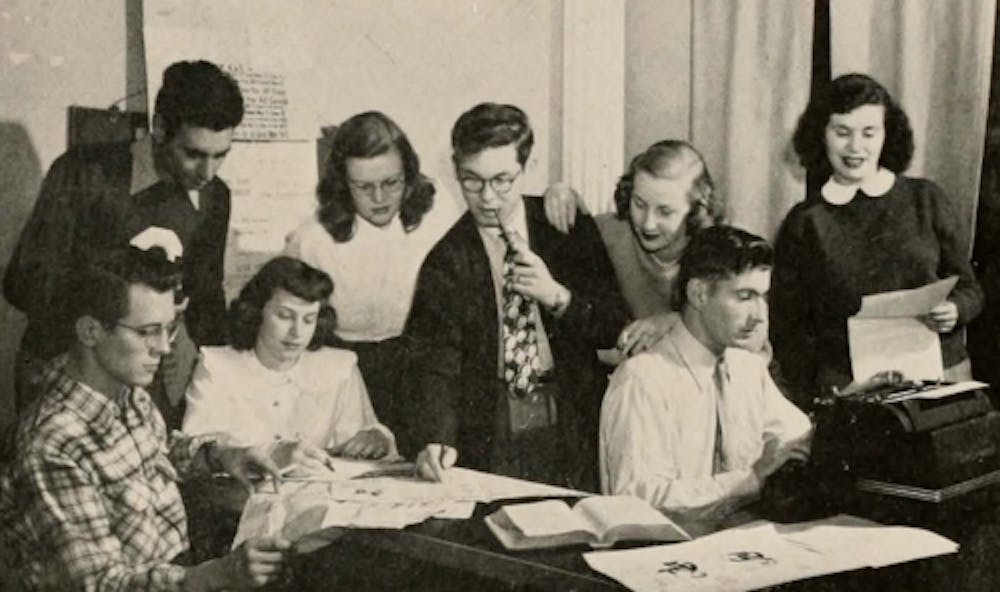The Post has undergone many transformations over the course of its century-long history, and will make another change as it transitions to a weekly tabloid and digital-first publication next year.
Ohio University’s independent, student-run newspaper, The Post, printed its last broadsheet paper Thursday.
The publication will transition to a weekly tabloid and digital-first format beginning Fall Semester 2016, but this isn’t the first transformation in the century-old newspaper’s history.
During the 1969-70 academic year, under the leadership of former Editor-In-Chief Andy Alexander, The Post adopted a new printing system and an unconventional distribution process to adjust to a significant cut in the subsidy the paper received from the university.
“We got a printer, not the Athens Messenger, we got one in Ravenswood, West Virginia, and we hired a truck driver named Dale to take the paper every night and drive it down across the Ohio River,” Alexander, a visiting professional in OU’s journalism school, said. “This was such a risky venture that we found out later the journalism faculty had quietly started a little pool as to how many days we would go before the paper wouldn’t appear. I’m happy to say we appeared every single day.”
Short articles about The Post in the student organization section in several editions of the Athena yearbook also suggest the paper was an ever-changing publication.
One article from 1996, titled “Improving with the Times,” detailed Post editors' thoughts on how a website could change the publication, which they hoped would “become completely different from the paper.”
Decades earlier, in 1941, The Post was a tri-weekly newspaper. In 1949, the newspaper increased from 10 pages a week to 12 and set personal records for readership and circulation.
“Any good news publication understands its audience, and understands that in order to meet the audience’s needs the best, they have to get the information to them in ways the audience is going to consume,” Hans Meyer, associate professor of journalism and chair of the Post Publishing Board said of the publication’s changes over the years.
Though The Post was frequently changing, controversy surrounding the paper’s coverage of campus and community news was consistent.
Post reporters had “built in cynicism” according to an Athena article from 1975, which listed complaints from several university and Athens community leaders, including Charles F. Harrington, former university director of informations systems.
“There are people who absolutely despise The Post and would do anything to get rid of it,” he said in the article.
{{tncms-asset app="editorial" id="5d7b7e50-0732-11e6-abaa-db9fb2219d02"}}
Former Athens National Bank President B. Tad Grover even blamed The Post for Ohio University’s decline in enrollment during the 1970s.
“Ask around the state why people aren’t sending their children here,” he said in the article. “They’ll tell you it’s because of The Post.”
Alexander said he received a number of complaints as editor-in-chief from students and community members who were “generally distrustful of (the paper) and at the same time a little bit curious.”
“I remember one baseball player got angry because we wrote an editorial, I think, calling for greater funding to go toward academics than the sports program and he showed up in the morning, wadded up the paper and threw it at me, a really fast curve ball,” he said.
Despite the criticism, Posties continued to take pride in their work.
"I think a lot of the criticism about The Post come from people who are uncomfortable having a newspaper around which tries to do a little muckraking," Susan DeFord, editor during the 1975-76 school year, said in the 1976 edition of the Spectrum Green yearbook.
Handling complaints wasn’t the only problem The Post routinely faced in the past century.
“Financial woes plague ‘The Post’ ” read a Spectrum Green yearbook headline from 1977. The university continued to cut the paper’s annual subsidy that year, putting pressure on the publication to sell more advertisements to break even financially.
Today, the newspaper still faces financial challenges.
“The Post is in a good situation where it’s been able to draw upon reserves from the past to make up for any kind of current deficiencies, because we know the market has been really challenging for media in general,” Meyer said. “The new plan that The Post has put forward, I think, is a really smart way to address some of those deficiencies and to ensure The Post will survive for a long time.”
{{tncms-asset app="editorial" id="2b009fde-e6f6-11e5-b470-73388e42f009"}}
The Post will print a tabloid-style publication every Thursday beginning Fall Semester of next year and continue to publish new content online daily.
“I would also say, and I truly believe this, the great days of The Post are ahead, in the digital era,” Alexander said. “There are so many different ways to tell a story. Is it scary? Yeah, because we don’t know how to make money yet, nor does even The Washington Post, The New York Times, they all struggle with the revenue model, but we’ll figure it out.”
Through it all, The Post has always held an importance to the City of Athens and Ohio University, according to the 1988 Athena yearbook.
“Whether you loved it, hated it, or loved to hate it,” the article read. “The Post is an institution in this town."
@mayganbeeler






